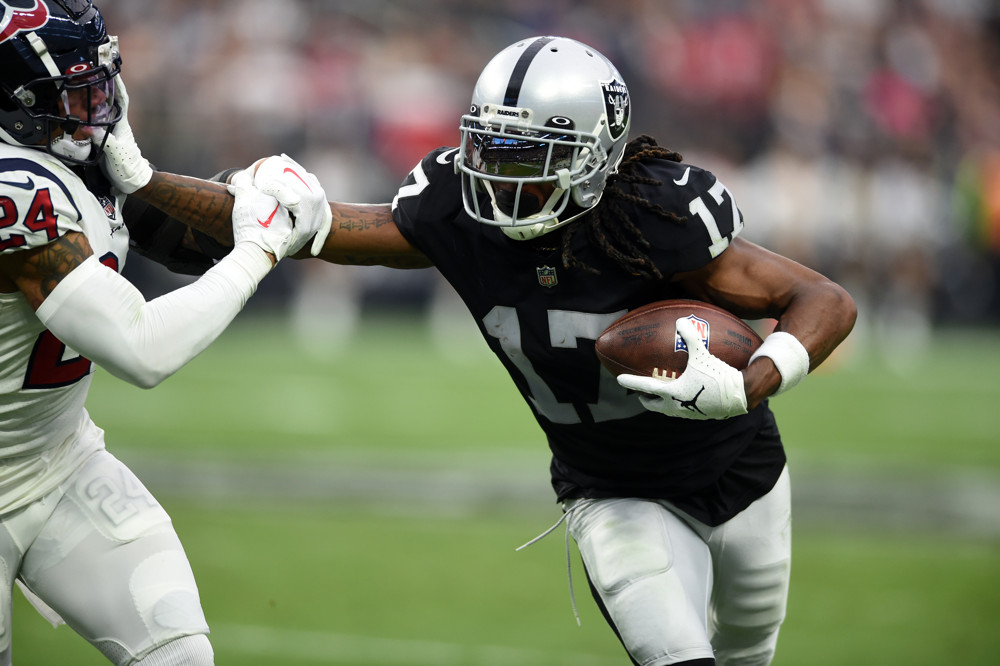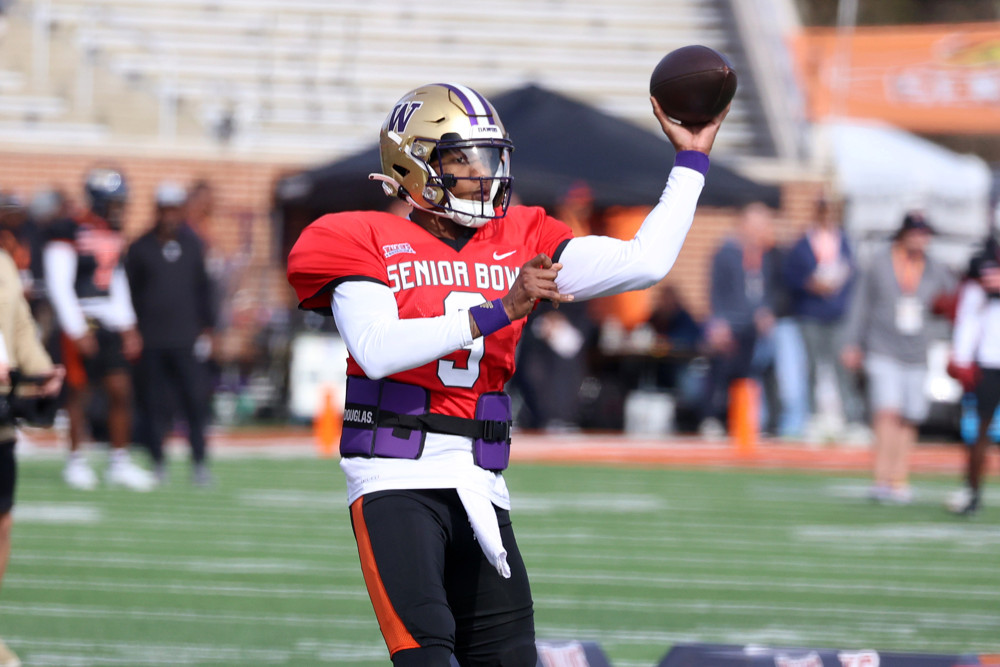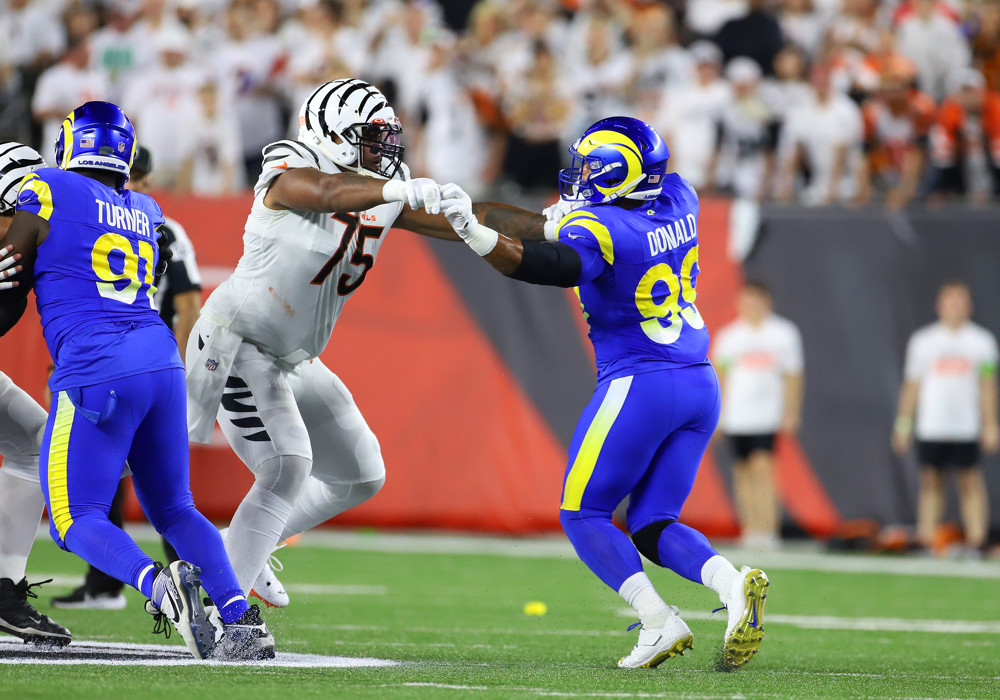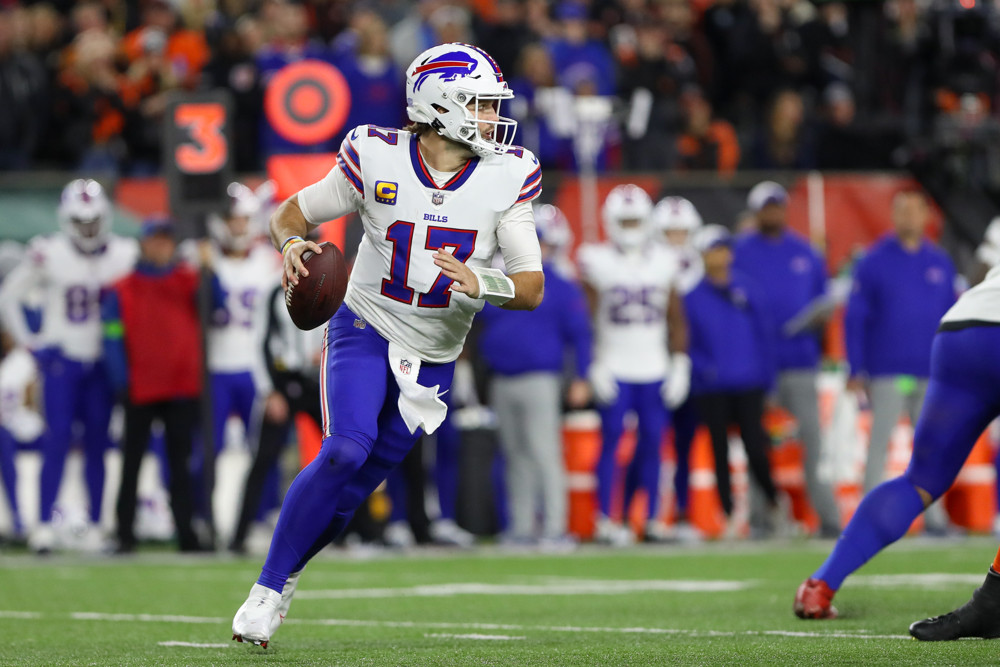
The very top of the Speed Score leaderboards is some rarified air. Since electronic timing started at the combine in 1999, only 11 running backs have hit 120 or higher; a number usually reserved more for track stars than NFL stars. We hadn’t had anyone join the club since Jonathan Taylor ran a 4.39 back in 2020, just squeaking over the bar at 121.7.
Welcome to the club, Isaac Guerendo.
Created by Bill Barnwell and introduced in Pro Football Prospectus and ESPN Insider back in 2008, Speed Score has been one of our metrics for evaluating running back prospects for nearly two decades. It’s built on the simple idea that smaller backs tend to run faster than larger backs, so we should be more impressed by a 4.5s 40-yard dash from a 220-pound back than the same clock reading from a 170-pound back. As such, Speed Score incorporates a back’s official time in the 40-yard dash with his weight to produce a measure of his speed given his size using this formula:
(Weight * 200)/(40 time^4)
The average running back who makes it to the NFL will have a Speed Score around 100.0, with most prospects at the position falling between 85.0 and 110.0.
Speed Score measures speed in the context of strength and power. It doesn’t measure agility, receiving ability, or any of the other aspects related to the position. It does not claim that a larger player with a higher 40 time is somehow faster than a smaller player with a lower 40 time thanks to the power of exponentiation. Speed Score is useful because it’s beneficial for a running back to be both fast and large.
Speed Score has a higher correlation with yards, carries, and DYAR than 40-yard times alone, making it a better way to contextualize the performances at the Underwear Olympics and a better tool for finding valuable players later in the draft. When combined with college production, it forms the basic of more complicated projection systems like BackCAST, which will arrive later this offseason on ESPN+.
Last year, your Speed Score leader was Deneric Prince (114.2), who found his way onto the Chiefs’ practice squad but had no in-game action. But Jahmyr Gibbs (110.1) was right on his heels, and Bijan Robinson (108.7) and De’Von Achane (108.0) weren’t that far behind. No one really broke Speed Score a year ago; those were fairly middling numbers for the top of a leaderboard, historically. This year, however, we had four players break 110 – and they come from all parts of the big board. Whether your team is looking to draft a running back early or digging for a late sleeper, Speed Score has someone for them.
Let’s start with the Speed Score table, and then discuss the notable names and numbers on it.
| 2024 Speed Scores | ||||
| Player | School | Weight | 40 Time | Speed Score |
| Isaac Guerendo | Louisville | 221 | 4.33 | 125.7 |
| Trey Benson | Florida State | 216 | 4.39 | 116.3 |
| Jaylen Wright | Tennessee | 210 | 4.38 | 114.1 |
| MarShawn Lloyd | USC | 220 | 4.46 | 111.2 |
| Kimani Vidal | Troy | 213 | 4.46 | 107.7 |
| Tyrone Tracy | Purdue | 209 | 4.48 | 103.8 |
| Michael Wiley | Arizona | 210 | 4.51 | 101.5 |
| Ray Davis | Kentucky | 211 | 4.52 | 101.1 |
| Keilan Robinson | Texas | 191 | 4.42 | 100.1 |
| Isaiah Davis | South Dakota State | 218 | 4.57 | 100.0 |
| George Holani | Boise State | 208 | 4.52 | 99.7 |
| Kendall Milton | Georgia | 225 | 4.62 | 98.8 |
| Blake Corum | Michigan | 205 | 4.53 | 97.4 |
| Dylan Laube | New Hampshire | 206 | 4.54 | 97.0 |
| Jaden Shirden | Monmouth | 187 | 4.45 | 95.4 |
| Dillon Johnson | Washington | 217 | 4.68 | 90.5 |
| Audric Estime | Notre Dame | 221 | 4.71 | 89.8 |
| Bucky Irving | Oregon | 192 | 4.55 | 89.6 |
| Emani Bailey | TCU | 202 | 4.61 | 89.4 |
| Cody Schrader | Missouri | 202 | 4.61 | 89.4 |
| Jawhar Jordan | Louisville | 193 | 4.56 | 89.3 |
Did not run: Rasheen Ali, Braelon Allen, Jonathon Brooks, Sevarian Edwards, Frank Gore, Jase McClellan, Will Shipley, Miyan Williams
Top Performers
We have to start with Louisville’s Isaac Guerendo. Any 40 time that’s 4.3X should turn heads, but that’s usually players just squeaking under the 4.4-second mark. Guerendo blew it away with a 4.33. Only six drafted running backs in the last 10 years topped a 4.33, and a bunch of those are skinny guys. Guerendo ended up as the fastest 220+-pound back since 2003, and has etched his name in Speed Score history.
| Speed Score 120 Club | |||||
| Year | Player | School | Weight | 40 Time | Speed Score |
| 2016 | Keith Marshall | Georgia | 219 | 4.31 | 126.9 |
| 2011 | Mario Fannin | Auburn | 231 | 4.37 | 126.7 |
| 2024 | Isaac Guerendo | Louisville | 221 | 4.33 | 125.7 |
| 2013 | Knile Davis | Arkansas | 227 | 4.37 | 124.5 |
| 2018 | Saquon Barkley | Penn State | 233 | 4.40 | 124.3 |
| 2010 | Ben Tate | Auburn | 220 | 4.34 | 124.0 |
| 2005 | Brandon Jacobs | Southern Illinois | 267 | 4.56 | 123.5 |
| 2004 | Kevin Jones | Virginia Tech | 227 | 4.38 | 123.4 |
| 2009 | Andre Brown | North Carolina State | 224 | 4.37 | 122.8 |
| 2009 | Cedric Peerman | Virginia | 216 | 4.34 | 121.8 |
| 2020 | Jonathan Taylor | Wisconsin | 226 | 4.39 | 121.7 |
| 2007 | Chris Henry | Arizona | 230 | 4.41 | 121.6 |
There’s always the fear that players who run this fast are sprinters masquerading as running backs, rather than actual NFL prospects. If you were to put the US track team onto the field, they would crush Speed Score … and then be crushed by an NFL linebacker slamming into them. And, yes, Guerendo has significant track-star pedigree; he won the state title in high school by running a 10.51 100-meter dash. That speed hasn’t always shown up on tape; you would expect more explosiveness from a player who can put up these kinds of numbers, and we didn’t always see that at Louisville — not as sudden of a runner as one might hope.
But man alive, did Guerendo destroy athletic testing. De’Von Achane turned heads a year ago running a 4.32 at 188 pounds. To put up basically the same time while carrying 30 more pounds on your frame is astonishing. And it’s not just the 40, either – Guerendo had the best vertical jump and the second-best broad jump among running backs. That’s an athletic profile that you simply do not see every day, and something running back coaches will want to continue to mold.
And Guerendo was certainly a draftable prospect before the Combine, too. He averaged 6.1 yards per carry last season, after transferring from Wisconsin to Louisville to get more reps as a fifth-year senior. He has some receiving chops (22 receptions last season), is solid enough in pass protection and has kick return experience; he’s not just a straight-line speed guy. Add in some buzz coming out of the Shrine Bowl, and he’s a prospect on the rise. Any team running a wide zone system would love to stick him in their rotation and see if they can’t squeeze just a little more production out of that athleticism. There might be a Shanahan-style team or seven that have just slid Guerendo onto their day two boards after watching him in Indianapolis. We already knew the Chiefs, 49ers, Eagles and Ravens had shown interest in Guerendo stretching back to Shrine Bowl week; that list got a lot longer.
Guerendo is still likely to see himself picked after the other backs who topped 110, however; they had more hype coming in and had impressive days of their own.
Florida State’s Trey Benson (116.3) was actually ahead of Guerendo through the first 10 yards; Guerendo just caught him once they both got up to full speed. He would have topped last year’s leaderboard. Benson was the highest running back coming in on multiple big boards, including Bleacher Report and DraftTek, and running a 4.39 40 should help some of the other boards come around on him. Benson still needs to work on making people miss, but he can bowl people over and them leave them in the dust.
Tennessee’s Jalen Wright (114.1) and USC’s MarShawn Lloyd (111.2) are the other day-two prospects who really stood out. Guerendo may have had the best time overall and Benson had the top 10-yard split among big-name prospects, but Wright was the fastest through five yards, topping 15 MPH right off of the gun. Lloyd was a step behind Benson and Wright, but only just – he’s a D’Andre Swift type who should see his name called in round two or three.
The Arian Foster and Devin Singletary Lines
Speed Score doesn’t guarantee anything, of course, but the higher your score, the better the career you generally have. You can see the production of backs fall off as Speed Score drops off in this table:
One of the better uses of Speed Score, I think, is as a negative indicator. You can run fast and still not succeed at actually playing football; you may be a track star in pads. But if you can’t run well in jockey shorts, the odds that you’ll transition into a successful running back in the pros drop dramatically.
For years, we’ve tracked some specific lines – floors for production. The worst speed score ever for a running back who topped 5,000 yards in his first five years belongs to Arian Foster, at 94.2. He’s the “1.1%” on the chart – the only running back with a Speed Score under 100.0 who managed to average 1,000 yards a season for five years. He’s the only player since electronic timing was introduced to have a below-average Speed Score and still develop into a superstar.
The other line we have historically tracked used to be the Ahmad Bradshaw Line. Bradshaw had a Speed Score of 87.7 back in 2007, and used to be the lowest-scoring back to hit 2,500 rushing yards in his first five seasons. That title can officially be handed to Devin Singletary now – five years after being drafted, Singletary has topped 4,000 yards despite a Speed Score of just 86.1 (a 4.66s 40 at 203 pounds). Singletary had a terrible day at the combine back in 2019, struggling in every drill, and yet has gone on to be a useable player, if by no means a superstar. He’s now the shining light in the darkness; the hope for players with awful days that they can still make an impact in the NFL. The point stands, however—if you’re being compared to the Bradshaws and Singletarys of the world, your chances of a successful NFL career rapidly approach zero.
No one dropped under the Singletary line, but we did have a top prospect fall under the Foster line this year. Notre Dame’s Audric Esteme managed just a 4.71 40 at 221 pounds, an extremely disappointing number for him. There really isn’t any drafted running back since 1999 with similar numbers who ended up doing anything at all in the NFL; the best comparison you can get is Olandis Gary (4.71 at 216 for a speed score of 87.8). Esteme has power and is really, really tough to tackle once he gets going, but his burst and acceleration don’t exactly jump off the screen. A 4.71 is definitely lower than expected, and some of his other testing numbers were fine – he had a 10’5” broad jump, for example. Both Daniel Jeremiah and Charles Davis, on the broadcast, said they were expecting a high 4.5, low 4.6. That would have put his speed score closer to 100 – nothing spectacular, but not concerning, either. A 4.71 is concerning. He’ll have to show off at his pro day, or the questions about his short-area burst are going to knock him down to Day 3.
Other Notable Names
The other names near the top of most big boards who ran were Kentucky’s Ray Davis and Michigan’s Blake Corum, both of whom clocked in just around 100 and were mostly fine. Corum’s 4.53-second 40 is a little disappointing but also not overly surprising nor harmful. We knew he lacked top-end speed; he’s more about finding small seams, finding lanes and making something out of nothing; his performance in the other drills helps make up for any sort of lack of top-tier speed. Ditto Davis, who is probably very happy with his 4.52. He’s a high-floor, low-ceiling player who is at least adequate all around; he doesn’t have a special trait that could have overcome a 4.6 or something but his size and efficiency could make him a useful player. He excelled in position work, too – he’s a better player than athlete, so the fact that he didn’t embarrass himself in the 40 is a win for him.
If you’re looking for more of a sleeper, however, try Troy’s Kimani Vidal (107.7). A small-school workhorse (315 touches last season!), Vidal worked behind a line we’re going to be generous and describe as questionable last season. Vidal racked up a ton of missed tackles at Troy, because tacklers were on him almost immediately and he had to juke and jive to survive. Well, it turns out, if he’s allowed a free release, he’s pretty fast – a 4.46 at 213, followed up by some impressive position drills, turned quite a few heads.
Vidal probably ran himself into the third day of the draft with his time, and is someone to keep an eye on as a sleeper in your rookie drafts and dynasty leagues going forwards.


































